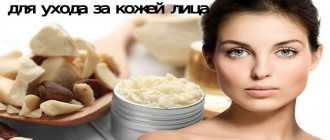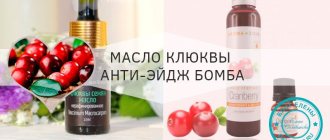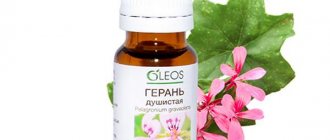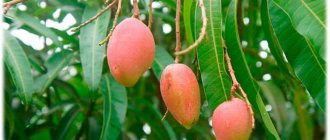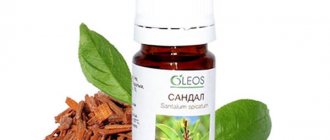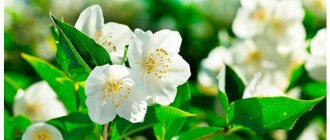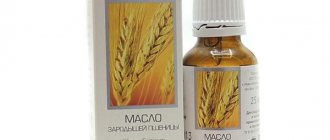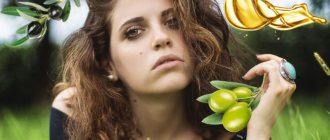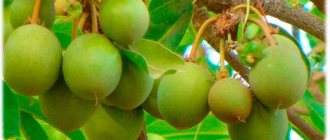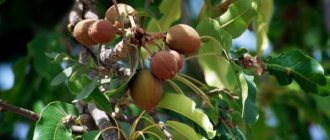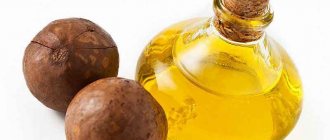The question of the naturalness of cosmetics haunts modern beauties. In contrast to aggressive environmental factors, poor nutrition and ecology, an abundance of chemical additives, fragrances and preservatives in cosmetics, girls and women are increasingly turning to natural oils and extracts.
Cocoa butter is a natural storehouse of healthy fatty acids and vitamins that can preserve the beauty, youth and health of the skin, refresh and even rejuvenate it. In common parlance, the product is also called “the gift of Aphrodite”; it is actively used in the preparation of nourishing and rejuvenating masks, creams, balms for the face and body.
Varieties and production technology
Cocoa butter is a popular product and fruit of the chocolate tree. To prepare it I use cocoa beans.
The oil preparation procedure occurs in several stages:
- The collected cocoa beans are peeled, filmed and sorted.
- The prepared raw materials are subjected to high temperature treatment and crushed into powder.
- Cocoa bean powder is fed to the hot pressing position.
- Depending on the purpose of the product, the oil is purified. Cosmetic oil undergoes more thorough purification than cooking oil.
The cocoa product has a dense, even fragile consistency and a pleasant aroma. The color of the product varies from light brown to rich chocolate. Before use, it is heated, melted in a steam or water bath. At a temperature of +32ºС, the product begins to melt, becomes fluid and convenient for application to the skin.
The chocolate product, despite the complex preparation process, does not lose its valuable properties and is widely used in cosmetology, aromatherapy, medicine and cooking. The drug is non-toxic and rarely causes an allergic reaction when used.
You won't be able to get cocoa butter at home.
Use in cooking
Best materials of the month
- Coronaviruses: SARS-CoV-2 (COVID-19)
- Antibiotics for the prevention and treatment of COVID-19: how effective are they?
- The most common "office" diseases
- Does vodka kill coronavirus?
- How to stay alive on our roads?
The most beloved and best-selling sweet in the world – chocolate – is made from cocoa butter. The oil is melted in a water bath, mixed with carob/sugar/honey/cocoa powder/nuts/spices/vanilla/dried fruits and packaged in colorful packages to attract customers.
When choosing chocolate, be sure to check the ingredients. Unscrupulous manufacturers often replace cocoa butter with cheaper ingredients such as carcinogenic fat or other substitute substances [10]. In high-quality, real chocolate, cocoa butter should be one of the first positions in the composition [11].
The product is an ideal confectionery fat: it is used to prepare biscuits, cakes, puff pastries and many other delights. Cocoa butter is not a frequent guest in salty/spicy dishes. The aroma, texture and properties of the product are exclusively suitable for the confectionery industry.
A little history
Cocoa butter has been used to preserve youth and beauty of the skin for a long time. The Mayan tribes thousands of years ago considered the chocolate tree a source of timeless beauty, and the resulting oil extract was used to heal wounds.
South Africa is considered the birthplace of the chocolate tree, although today the plant grows successfully in America. For many centuries, Africans have used the oily product to protect their skin from the rays of the burning sun, noting its high protective, healing and moisturizing properties.
Beneficial features
The aromatic product made from cocoa beans has a pronounced antioxidant, moisturizing effect, nourishes, softens the skin and increases its protective properties. The product contains a complex of fatty acids:
- linoleic acid - a natural moisturizer, relieves dryness and flaking;
- lauric - prevents moisture loss in epidermal cells;
- stearic – protects the skin from attacks of harmful bacteria and infections, reduces the inflammatory process;
- oleic - stabilizes lipid balance, prevents the appearance of acne and acne;
- palmitic – evens out skin color, lightens age spots;
- arachina - acts as a transporter of nutritional components deep into the integument, providing a quick effect from the use of cocoa extract.
In addition to fatty acids, natural cocoa butter is rich in vitamins K and E. Vitamin K promotes rapid healing of microwounds and cracks, blocking the inflammatory process. The high content of beauty vitamin E determines the high antioxidant properties of the chocolate product, has a rejuvenating effect, and preserves the beauty and elasticity of tissues.
Phytosterols are another assistant in matters of tissue rejuvenation and regeneration. We must not forget about other important macro- and microelements (magnesium, zinc, potassium, chromium, copper, manganese, phosphorus, calcium, iron). Together, they improve metabolic processes in skin cells, strengthen and increase their functionality.
Cocoa butter can be safely used in its pure form or as an additive to ready-made products, other natural oils and extracts.
Attention! The aromatic product made from cocoa beans, even in its pure form, does not irritate the skin, acts gently and effectively, and is suitable for all types of epidermis.
Benefits for the skin
Cocoa butter has a fairly dense and buttery texture and retains an amazing chocolate aroma.
First of all, its value lies in its truly golden composition, rich in microelements.
- Due to the high content of fatty acids (stearic, linoleic, etc.), the oil promotes the formation of a water-lipid layer that protects the skin from environmental influences. As a result, the skin adapts more easily to harsh weather conditions: frost, wind and heat.
- Palmitic acid stimulates the natural processes of production of elastin, collagen and hyaluronic acid in skin cells. As a result, the firmness and elasticity of the skin increases, small wrinkles are smoothed out.
- Lauric acid and potassium retain water molecules at the cellular level, preventing dehydration of the epidermis. Vitamin E deeply nourishes cells.
And in contrast to the smoothing effect, the result of moisturizing with cocoa butter is visible almost immediately - flaking and tightness are eliminated, the skin is softened.
- Vitamins A and B, which are components of cocoa butter, have a beneficial effect on the condition of the skin. Vitamin A and stearic acid heal and dry out acne, while vitamin B9 soothes irritated skin. Oleic acid prevents clogged pores.
- Cocoa bean ingredients such as theophylline and theobromine have a beneficial effect on skin tone and accelerate metabolic processes, improving complexion. They are actively used in anti-aging cosmetics to solve the problems of aging skin.
- The presence of the same palmitic extract makes cocoa butter indispensable for lightening skin pigmentation.
Natural cocoa butter used in cosmetology is thoroughly purified from impurities and additives. Therefore, the end result is an exceptional, pure product that is effective, easy to use and universally suitable for every skin type.
Indications for use
The list of problems that cocoa butter can cope with is quite wide. Thanks to its valuable, multi-component composition, the product is actively used in medicine and cosmetology.
Indications for the use of cocoa butter for facial skin are:
- signs of age-related withering of the integument;
- expression and age wrinkles, crow's feet;
- stretch marks, scars or acne on the face;
- dull, unhealthy color of the integument;
- dryness and flaking or, conversely, increased oiliness of the skin;
- decreased tone and turgor;
- skin hyperpigmentation;
- frequent acne, inflamed pimples.
Cosmetologists also recommend using chocolate tree extract for preventive purposes, to prevent early aging of the skin. The client's skin type and age are not particularly important.
Important point! You can even apply cocoa butter and formulations containing it to the sensitive area around the eyes and to the surface of the lips. A valuable product will only bring benefits, improve their condition, and fill them with nutritional components.
In medicine, cocoa bean oil is used to strengthen the immune system and treat eczema and other dermatological ailments.
Compound
Cocoa butter is a complex compound that contains many components. The most important elements are:
- fats. The main component of the product. Their content ranges from 90% to 99%. Of these, the majority is oleic acid, which contains active antioxidants. The oil contains stearic, palmitic, lauric, and arachidic acids. These substances are important elements of metabolic processes occurring in the dermis, and the lack of these compounds negatively affects the condition of the skin. For example, palmitic acid prevents tissue dehydration, and lauric acid effectively protects the skin from pathogenic bacteria and viruses;
- substances from the polyphenol group. These compounds have a pronounced antihistamine effect;
- vitamins. A rich set of these compounds enhances the beneficial properties of the oil. Cocoa contains fat-soluble vitamins A, E and F and water-soluble vitamins C, group B.
The oil contains vitamins, polyphenols, fats.
Cocoa butter also contains a rich set of poly- and monosaccharides, plant steroid alcohols, and proteins necessary for the skin and the body as a whole. The product also contains such important microelements as potassium, calcium, magnesium, zinc, phosphorus and iron.
The oil is available in refined and unrefined forms. After refining, the product loses most of its beneficial substances, but its shelf life increases significantly. For therapeutic and cosmetic purposes, the unrefined product is more valuable.
Where can I buy
It is not difficult to buy vegetable oils and extracts. Pharmacies, online stores, cosmetics stores and supermarkets are ready to offer many options, but it is difficult to answer how natural and high-quality they will be.
Study information about the manufacturer, ask for reviews from users and friends, pay attention to the packaging and storage conditions of the product, how it looks and smells.
When choosing a product, pay attention to the following criteria:
- Smell - the product should smell like cocoa. You can only miss the rich aroma if you buy refined oil.
- Color - cream. A gray or perfectly white tint indicates a fake or damaged product.
- Consistency - a natural product is solid at normal temperatures and may crumble. The plastic consistency should alert you.
- Price – don’t count on too cheap prices, the cost of the product increases every year.
Cocoa butter is an inexpensive product, its price starts from 300 rubles and above. The product is often packaged in a plastic or glass jar with a wide neck to make it easy to remove.
The product can be stored for 2 years from the date of manufacture. The optimal storage temperature is 18ºС. Cocoa butter should not be frozen.
Production Features
Cocoa butter is obtained by processing beans. The process is complex, multi-stage. The hot method is used. As a result of processing, cocoa powder and cocoa butter are obtained. It is a hard, brittle product with an oily texture. It has a pleasant milky-nutty aroma. It acquires a liquid consistency at a temperature of +32-35°C. When heated to 40°C it becomes transparent, in the solid state the color can vary from cream to brown.
When properly produced, the oil retains all the valuable properties of the beans, but unrefined oil is still considered to have more vitamin content, although more purified, refined oil is more actively used in cosmetology.
General recommendations for use
The effectiveness of any cosmetic product largely depends on the technique and frequency of use. Expert advice will help you achieve maximum results:
- Apply the prepared mask, balm, cream or pure melted cocoa butter only to cleansed skin. Firstly, the nutritional components will penetrate deeper into the skin faster, and secondly, there will be no clogging of the pores.
- Choose a recipe for a mask, balm, or cream with natural ingredients taking into account the type of epidermis.
- Before using the prepared composition, perform a rapid allergy test. Despite its many-sided benefits and versatility, even cocoa butter can provoke an allergic reaction and irritation of the skin.
- Strictly follow the recipe and frequency of use of cosmetic products so as not to provoke the appearance of other skin problems.
- All ingredients, including cocoa butter, must be of high quality. Expired products will not bring any benefit and can even significantly deteriorate your health.
- Fragrant cocoa butter can be applied to the area around the eyes and lips without fear.
- The presence of abrasions and scratches on the skin is not a contraindication; on the contrary, cocoa extract will contribute to their rapid healing.
- Before using the extract, it must be melted in a water or steam bath.
- There is no need to immediately make a large amount of a natural face mask; over time, its beneficial properties noticeably fade away.
- A natural product without additives is quickly absorbed, so you can apply it 15-20 minutes before bed or before going outside.
- Cocoa butter can replace any cream; just apply a little product to the skin of the face, lips, body, and hands.
By the way, cocoa butter extract is an excellent protector from scorching sun rays. Spread a little product on your skin when going to the beach to avoid burns.
Indications and contraindications
Thus, it is obvious that the use of cocoa butter in skin care procedures is ideal both in the case of the manifestation of individual aesthetic imperfections of the skin, and as an element of comprehensive care and prevention of age-related changes.
Let us specify the indications for using this product:
- Dry skin, including severe flaking and itching;
- Problem skin with acne, minor inflammations;
- Sensitive skin prone to irritation;
- Skin with signs of aging - from the first facial wrinkles to pronounced changes;
- Dull dehydrated skin;
- Pigmented skin;
- Oily skin with signs of disruption of the sebaceous glands;
- Skin exposed to UV rays in sunny weather.
Cocoa butter is ideal for dry skin.
Note that although the indications for the use of this herbal product are unusually varied, a number of cautionary points can be identified:
- Firstly, the presence of an allergic reaction to cocoa
Therefore, it is important to test by applying a little oil to the crook of your elbow. If no irritation appears after 10-15 minutes, you can proceed further.
- Secondly, take into account the individual characteristics of your skin in terms of comedones. Cocoa butter, like any other natural oil, can clog pores. This in turn leads to the appearance of inflammatory processes and enlarged pores.
If you have such concerns, ensure that your skin is thoroughly cleansed before using the oil. If your skin is excessively oily, degrease it as thoroughly as possible beforehand.
Popular methods and recipes for use
There are several ways to use cocoa butter, popular among them:
- Application to the face and body in its purest form. A natural extract can replace the usual oil or cream, protect the skin in windy weather, cold and heat, refresh and soften the skin. Melt a little product and apply to the cleaned surface, complete the procedure with a light massage, patting, pinching.
- Adding to finished cream, face balm. Cocoa butter can make your usual cosmetic product even more effective and healthy. Melt a little natural product and mix with the finished cream and balm. Distribute the enriched cosmetic product onto your face according to the instructions.
- Preparing a homemade mask, cream, facial scrub. This is perhaps the most popular way to cope with imperfections and skin problems. The choice of product formulation depends on the characteristics of the skin and the blemishes that you want to correct. We have several proven and effective beauty recipes in our arsenal.
A gentle scrub with a moisturizing effect can be prepared from the following ingredients:
- 1 tbsp. l. cocoa butter;
- 1 tsp. natural honey;
- 1 tsp. chopped oatmeal;
- 1 tsp. powdered almonds.
Melt the oil ingredient in a bathhouse, add the rest of the scrub ingredients and mix well. Pour the homogeneous mixture into ice molds and leave to harden. Use the prepared squares to wipe your face, paying special attention to problem areas near the wings of the nose and on the forehead.
It is recommended to store the homemade scrub for no longer than 30 days in a cool place (in the refrigerator). But do not forget, over time the usefulness and effectiveness of the product decreases.
A nourishing mask with a lifting effect with the addition of cocoa bean extract is an excellent opportunity, without chemicals or preservatives, to correct age-related changes on the face, give the skin elasticity and freshness, and fill it with important components and moisture. To prepare you need to take:
- 1 tbsp. l. cocoa extract;
- egg yolk;
- 1 tsp. liquid honey;
- 5 drops of freshly squeezed lemon juice.
Preparation and use: mix all ingredients into a homogeneous mass. Distribute the composition onto pre-cleaned surfaces for 15 minutes, then rinse with water. The mask is ideal for clients 35+.
A mask with a rejuvenating effect will cope with shallow wrinkles on the face, eliminate oily shine, and tighten pores. To prepare it use:
- 40 g white clay;
- 20 ml natural cocoa extract;
- 10 g ground oatmeal;
- 15 ml low-fat kefir or yogurt without additives.
Mix all ingredients until smooth and spread onto cleansed skin in an even layer. Remove any remaining mask after 15 minutes.
A mask that will refresh and even out the complexion, make the skin soft and silky, is prepared from the following ingredients:
- 9 g fresh parsley;
- 6 ml cocoa extract.
Grind the parsley leaves until the juice appears. Add oil extract. Spread the prepared mixture over the surface of your face. After 30 minutes, rinse off the mask with cool water.
For combination skin , try a nourishing mask with cocoa extract and aloe extract. The mixture has a healing effect and helps smooth out fine wrinkles. To prepare you will need:
- 1 tbsp. l. grape seed oils;
- 1 tsp. cocoa extract;
- 1 tbsp. l. juice or pulp from aloe leaves.
The cooking process takes no more than 5 minutes. Melt the cocoa butter and add the remaining mask ingredients. Mix everything well and apply to the face and décolleté. After 15 minutes, rinse off the remaining mixture with cool water.
For dry skin, you should try a composition of the following ingredients:
- 1 tsp. wheat germ oil extract;
- 1 tsp. cocoa butter;
- 1 tbsp. l. avocado pulp.
Mix melted cocoa butter with other ingredients. Distribute the nutritious paste onto pre-cleaned skin and leave for 15–20 minutes. Afterwards, wash your face with warm water. If you do not have time to wait until the remaining oil composition is completely absorbed, wipe your face with warm milk.
a nourishing night cream for facial skin yourself. To do this you will need:
- 1 tsp each oil extracts of sea buckthorn and rose hips, olive oil or jojoba;
- 1 tbsp. l. cocoa butter;
- 3 drops of liquid vitamins A and E;
- 1 tbsp. l. usual face cream.
Mix all ingredients and leave in a cool place to harden. Apply the prepared cream to clean skin before going to bed. The product is best stored in the refrigerator.
Structural and functional features of newborn skin
Recent studies have shown that the skin of a healthy full-term newborn is structurally and functionally immature compared to the skin of an adult; the process of physiological maturation continues during the first year of life. The main function of the skin is to maintain internal homeostasis by preventing water loss, thermoregulation and protection from external influences and the penetration of microorganisms.
The barrier function of the skin mainly depends on the integrity of the outermost layer, the stratum corneum, its structure is similar to a brick wall in which the corneocytes, the “bricks”, are surrounded by intercellular lipid plates that act as a mortar, which ensures the integrity and permeability of the skin at the same time. During differentiation, the plasma membrane of the outer keratinocytes is replaced by the keratinized membrane of corneocytes, which gives the cells a certain rigidity.
The skin of the fetus can quite fully realize all functions already from the 30th week of gestation; at the 34th week, the epidermis is already well developed in the fetus; by the 37th week, the stratum corneum is almost completely mature. The upper layer of the epidermis, despite its thickness of only 7–35 microns, which is on average 20–30% less than that of an adult, mainly performs the protective and regulating functions of the skin barrier. Corneocytes in newborns are smaller, since after birth there is active cell proliferation, but cell maturation occurs relatively slowly, this process continues in the second year of life. Newborn skin is also more susceptible to stretching and shrinking due to the weak dermoepidermal junction. After birth, adaptation to the ectopic environment changes the hydration of the stratum corneum, the surface pH of the skin, and the permeability of the stratum corneum to water, which affects transepidermal fluid loss (TEFL). The stratum corneum of the skin of newborns and infants contains more water, but less natural moisturizing factors, because of this, skin hydration at birth decreases, TPE increases, and therefore the skin of newborns after birth is much drier than that of adults. The hydration of the stratum corneum and the pH of the skin surface constantly change during the neonatal period, and the rate of these changes depends on the body site and the care of the child [2–4]. During the first month of life, skin hydration in infants increases and continues between 3 and 24 months of age. becomes higher than in adults [5, 6]. During this period, the stratum corneum smoothes out. Skin water content also influences barrier function by regulating the activity of hydrolytic enzymes that are involved in the maturation and desquamation of corneocytes. Components of the natural moisturizing factor in corneocytes, such as free amino acids, pyrrolidone carboxylic acid, lactic acid, urocanic acid, organic acids, peptides, sugars, urea, citrate, glycerol and many others, contribute to the hydration of the stratum corneum. Filaggrin, one of the markers of terminal differentiation of the epidermis, also provides hydration of the stratum corneum, is broken down into free amino acids, which are further metabolized to hygroscopic derivatives, such as pyrrolidone carboxylic acid, a glutamine derivative, and urocanic acid, a histidine derivative.
At birth, the pH of the skin characterizes the environment as alkaline. In the first seven days, the pH changes from almost neutral to neutral, followed by a decrease over the course of a month, as the acidic reaction of the skin provides protection against the penetration of pathogenic microorganisms [7]. Insufficiently formed acid mantle and skin microbiome, gradual maturation of the immune defense system cause a higher risk of pathological microbial colonization and the frequent occurrence of infectious and inflammatory skin diseases in newborns and infants, especially with defects in care.
Currently, the effect of the pro-inflammatory cytokine interleukin-1α on the maturation of the skin barrier of the fetus and newborn is being actively studied. It has been established that the relatively low level of this cytokine increases in the neonatal period, which may contribute to the maturation of the skin barrier [8]. Microbial colonization of human skin begins immediately after birth, but the necessary balance between the numerous microorganisms colonizing the baby's skin is achieved only by the end of the first year of life. It has been suggested that microbial colonization of the skin during the neonatal period significantly influences the development of skin immune function and possibly the maturation of other barrier functions, as well as the development of the immune system in general [9].
Thus, the immune defense system of the skin of a newborn and a child of the first year of life, consisting of immediate nonspecific (innate immunity) and delayed (adaptive immunity) mechanisms, is in the process of maturation, which makes their skin vulnerable.
In the keratinocytes of the granular layer, lipids are synthesized - precursors of ceramides, free fatty acids (FFA), cholesterol, some of which are then released from lamellar bodies into the space between the stratum corneum and granular layer, while the remaining lipids are secreted onto the surface of the skin by the sebaceous glands (cutaneous salo). The barrier that ensures skin permeability depends on the state of the intercellular matrix containing ceramides, FFAs and cholesterol. After secretion from lamellar bodies, intercellular lipids are modified by enzymes and become intercellular lamellae. They mainly consist of saturated fatty acids, among which palmitic (C16:0), stearic (C18:0), behenic (C22:0), lignoceric (C24:0) and hexacosanoic (C26:0) acids predominate [10] . Content of polyunsaturated fatty acids, such as oleic (C18:1, n-9), eicosapentaenoic (C20:5, n-3), arachidonic (C20:4, n-6), docosahexaenoic (C22:6, n-3) acids , as well as linoleic acid (C18:2, n-6) and its derivatives - linolenic [α-linolenic (C18:3, n-3), γ-linolenic (C18:3, n-6)] and dihomo-γ -linolenic (C20:3, n-6) acids, significantly less in the stratum corneum than saturated fatty acids. Linoleic acid is the most common polyunsaturated fatty acid; however, in addition to linoleic and arachidonic acids, other FFAs are also synthesized in keratinocytes [11].
The epidermis is also characterized by active metabolism of polyunsaturated fatty acids. Linoleic acid, the major 18-carbon n-6 polyunsaturated FFA in normal epidermis, is metabolized in the epidermis through the 15-lipoxygenase pathway, mainly to 13-hydroxyoctadecadienoic acid, which has antiproliferative properties [12].
Arachidonic acid, the second most important polyunsaturated FFA in the skin, is another substrate of 15-lipoxygenase, by which it is converted to 15-hydroxyeicosatetraenoic acid (15-HETE). 15-HETE inhibits leukotriene B4-induced chemotaxis of polymorphonuclear neutrophils [13]. However, arachidonic acid is mainly metabolized through the cyclooxygenase pathway into prostaglandins E2, F2α and D2. At low concentrations, prostaglandins modulate skin homeostasis, whereas at high concentrations they cause skin inflammation and hyperproliferation of keratinocytes [14].
Beauty recipes for lips, eyelashes and eyebrows
Cocoa butter perfectly softens and nourishes the skin, so it is often used to make lip balm. Take note of a few effective recipes:
- Mix almond and sea buckthorn oils (1 tsp each), add melted cocoa butter (1.5 tbsp) and a capsule of liquid vitamin E. Stir the mixture until smooth and refrigerate to set. In the future, apply the product to the surface of your lips, especially when going outside.
- Melt beeswax and cocoa butter (1 tbsp each) until fluid, add 2 tbsp to the mixture. l. wheat germ oil or other favorite oil. When the mixture hardens, use it as a lip balm.
The aromatic oil extract can also be used to stimulate the growth of hair, eyelashes, and eyebrows. a little product to the ends of your eyelashes and eyebrows to make them thicker and more beautiful. Repeat the procedure several times a day.
Cocoa is a specific type of plant that is native to the subequatorial latitudes of South America. Recently, cocoa has become increasingly popular, because it helps not only to maintain health, but also youth and beauty of the body. Cocoa has unique properties, due to which it is widely used in cosmetology, cooking and pharmaceuticals.
Cocoa butter: beneficial properties and applications
Cocoa butter is a fat that is obtained from the beans of the Cocoa tree. It contains a large amount of fatty acids and triglycerides. Palmitic and oleic acid increase the elasticity of the walls of blood vessels, promote natural blood purification, and gradually reduce cholesterol in the blood.
This product is widely used in medicine to treat coughs, stretch marks, and burns. Added to various healing ointments and suppositories.
Cocoa butter is no less relevant in the field of cosmetology, as it has excellent antiseptic and tonic properties due to the content of tannins, methylxanthine, and caffeine. It is on the basis of cocoa butter that a large number of skin care creams, including soaps and lotions, are produced.
Cocoa butter is considered an excellent fatty base for various desserts, including chocolate. This product is of natural origin, has a pleasant and appetizing aroma, making it even more desirable for use.
Cocoa butter for facial skin
Natural cocoa butter is a product that is extracted by extracting vegetable fat without the use of additional substances. The use of this component is very beneficial for facial skin and has an effective effect.
By its nature, this substance is unique, as it helps normalize enlarged pores and remove oily shine, is ideal for moisturizing the epidermis, and helps get rid of the problem of flaking and dryness.
Cocoa butter quickly restores radiance to the skin and eliminates pallor. Regular use of masks containing this component helps maintain facial skin tone when the first age-related changes appear. The product is instantly absorbed into the skin and does not leave an unsightly shine on its surface.
By regulating the fat metabolism of the epidermis, cocoa butter removes inflammation and irritation, accelerates the healing process of minor wounds, abrasions and scratches. Ideal for use in the cold season, as it protects the skin from frost and frostbite. If you use cocoa butter regularly, the skin's natural production of collagen and hyaluronic acid is enhanced.
Using pure cocoa butter
Cocoa butter can be added to various cosmetic products or used in its pure form:
- The facial skin is first cleaned of dust and cosmetic residues.
- A small amount of pure cocoa butter is applied to the skin.
- Before applying the oil, you need to warm it up in your hands.
This cosmetic procedure is best performed in the evening, before bed, using instead of the usual caring cream. This product is ideal for combating various age-related skin changes, including eliminating flaking.
To remove dark circles under the eyes, relieve puffiness and refresh the complexion, it is recommended to apply cocoa butter to the area around the eyes. If vitamin deficiency develops or after an extension procedure, it is useful to apply cocoa butter in small quantities to eyelashes and eyebrows.
Cocoa butter cream
Cocoa butter can be an excellent base for making homemade cosmetic cream. This product retains its properties for a long time, provided it is stored in the refrigerator:
- Cocoa butter (25 g) is melted in a water bath, after which jojoba oil (5 ml) and olive oil (30 ml) are added. All components are mixed well until a mixture of homogeneous consistency is obtained. The composition is left for a while until it cools down - you can place it in a container filled with cold water. Next, add sandalwood essential oil (2 drops) and the cream is ready for use.
- Mix cocoa butter (25 g) with paraffin (5 ml) and lanolin (5 ml), add Vaseline (15 g). The mixture is placed in a water bath and stirred constantly. As soon as the components are melted, preheated rose water (45 ml) is introduced. The mixture is well mixed and whipped with a mixer, cooled. The cream is ready to use - you need to store it in a container with a tightly closed lid in the refrigerator.
Cocoa butter masks
At home, you can quickly and easily prepare natural cosmetic masks using the following recipes:
- To lighten and moisturize the skin, melt cocoa butter (6 ml) in a water bath. Add fresh aloe juice (7 ml) and chamomile essential oil (5 ml). Cucumber, previously grated, is added to the mixture. The resulting composition is applied to the skin of the face and left for 30 minutes.
- To nourish and cleanse the skin, take cocoa butter (25 ml), light honey (18 ml) and brown sugar (15 g). All components are thoroughly mixed. The finished mask is applied to previously cleansed facial skin. After 10 minutes, you need to wash your face with cool water.
- To remove small wrinkles in the eye area, you will need to take vitamin E (4 drops), sea buckthorn oil (10 ml), cocoa butter (5 ml). All ingredients are mixed well and the mixture is applied in a thin layer to the skin around the eyes. The mask is left for 15 minutes, then washed off with cool water. This cosmetic procedure is best done before bed.
Cocoa butter for body care
This unique product can be used for both prevention and treatment. There are several options for using cocoa butter in body care:
- Cleansing scrub - first melt cocoa butter (2 tbsp) in a water bath, add natural honey (1 tbsp), a mix of ground nuts (1 tbsp), add oatmeal. All components are mixed and the mixture is left for a while until it cools. The resulting mass is applied to the skin of the body and a light massage is performed. This procedure will not only help cleanse the skin of dead particles, but also have a stimulating effect on blood vessels.
- For massage it is useful to use a mixture of cocoa butter with olive and castor oil. All components are taken in equal quantities.
- Wraps for stretch marks and cellulite - melt cocoa butter in a water bath, add olive and almond oil. The resulting mixture is applied to problem areas, and a layer of plastic film is placed on top. Then you need to cover yourself with a warm blanket and lie quietly for 40–45 minutes. After the specified time has passed, take a warm shower. To get a positive result, you need to complete a full course of wraps, which consists of 10 procedures - 2-3 wraps are done per week.
Cocoa butter for hair care
Every girl can independently use cocoa butter for hair care at home. This natural remedy helps moisturize and nourish strands, especially if its application is combined with a scalp massage. As a result, more nutrients are supplied to the hair roots and blood circulation improves.
For hair care you can use the following recipes:
- A mask with the addition of cocoa butter helps stop hair loss. The product contains kefir and olive oil, boiled egg yolk. All components are thoroughly mixed until the mass acquires a homogeneous consistency. The mixture is applied to the hair, to the root area and left for 60 minutes. The head is covered with polyethylene and insulated with a towel. The mask is washed off with plenty of warm water. It is recommended to carry out this procedure several times a week.
- To maintain the beauty and health of your hair, it is useful to make a mask with the addition of cocoa butter. The composition includes rosemary infusion - 1 tbsp. boiling water is poured 2 tbsp. l. raw materials. The finished mask is applied to the hair and left for 2 hours. The product is washed off with warm water and shampoo.
How to make cocoa butter at home?
Today, cocoa butter is a completely affordable product that can be easily found in a pharmacy or specialty store. Natural butter is produced by various companies both in the form of a solid bar and a liquid substrate or cocoa powder.
Anyone can easily and quickly prepare their own cocoa butter at home, which will be much better than a store-bought product. To do this you need to adhere to the following scheme:
- First of all, you need to choose only high-quality cocoa beans. The ideal option would be to use unspoiled and well-ripened fruits.
- Cocoa beans are roasted well in the oven for 25 minutes at 120? C.
- Then the fruits are left for a while until they cool down or are simply blown with a fan, due to which all excess husks are removed.
- Using a blender or coffee grinder, grind the product until a homogeneous mass is obtained.
- The mixture is passed through a juicer, but only in small portions.
- The liquid that will be obtained is cocoa butter.
- At room temperature in its natural form the product becomes hard very quickly.
Before use, you simply need to melt the cocoa butter in a water bath.
Cocoa butter: benefits and harms
Cocoa butter is incredibly healthy in its pure form. If the product does not contain various foreign impurities, it can be used for various purposes. For example, this remedy helps cure cough, restore skin balance, accelerates the healing process of wounds, and effectively prevents age-related changes. That is why cocoa butter is universal and has a wide range of actions.
However, even such a valuable product can be harmful. The thing is that it has a high calorie content. Cocoa butter contains a large amount of fatty acids. That is why nutritionists advise minimizing the consumption of this product. First of all, these recommendations apply to people suffering from obesity and in case of diagnosis of a disease such as diabetes.
Before you start using cocoa butter, you must conduct an allergy test, since if it is present, the use of this product is strictly prohibited. This product has no more contraindications, with the exception of individual intolerance.
For more educational information about cocoa butter, watch the following video:
More interesting articles
Can it be taken internally?
The cosmetic product should not be taken orally or added to food; edible cocoa butter is used for these purposes. It is used in the production of white chocolate and confectionery.
It is recommended to use the aromatic extract for those whose bodies are sensitive to sudden changes in weather, and for people with low blood pressure. Regular use of this valuable product improves brain function, normalizes the functioning of the cardiovascular system, and reduces the risk of heart attack and cancer. Please note that the product is very high in calories, excessive consumption may affect your figure.
For coughs, colds, and sore throats, the aromatic chocolate product will also come in handy. It is enough to consume a little oil (the size of a small pea) every 4 hours.
The product stimulates the removal of mucus. You can prepare a delicious and medicinal drink. To do this, add ½ tsp to warm milk (1 tbsp.) cocoa butter, 1–2 tsp. natural honey. Stir the ingredients and wait until they are completely dissolved. Believe me, with this medicine your children and you will always be healthy.
By the way. You can get valuable components from cocoa powder. A hot drink will give you energy before your planned workout, improve your mood and well-being.
Application in medicine
Due to its unique medicinal properties, cocoa butter has found application in medicine as a complementary treatment for many diseases. The benefits of the product when applied to the skin are so great that it is used as a basis in the production of external preparations for the treatment of dermatological, allergic, vascular and many other pathologies.
Doctors also prescribe cocoa in the treatment and prevention of various diseases of the cardiovascular system, respiratory system, as well as to prevent infection with respiratory infections.
For cough and sore throat
When treating the respiratory tract, the oil is used both internally and externally. The product has not only a bactericidal, anti-inflammatory and antiviral effect, but also an antitussive effect, and also increases general nonspecific immunity. The most commonly used recipes are:
- Taking a teaspoon of cocoa butter three times a day, dissolved in a glass of warm milk, will help calm an unproductive cough. This remedy can also be used to treat small children, only a single dose of cocoa should be no larger than a pea;
- Resolving a teaspoon of the product in the mouth will help reduce pain and inflammation with sore throat;
- Taking half a teaspoon of a mixture of 10 parts cocoa butter and 1 part propolis will also help speed up recovery from a sore throat. You need to drink this mixture 3 times a day.
Can be used for colds.
Also, for coughs or sore throats, this useful product is used externally. In this case, you need to rub the oil on the chest in front and behind at night and wrap it warmly.
For atherosclerosis
Cocoa butter, when taken orally, also has a beneficial effect on liver function, which leads to normalization of the ratio of low- and high-density lipoproteins in the body. Thus, regularly taking half a teaspoon of a product intended for oral use, twice a day, a quarter of an hour before meals, will protect blood vessels from the deposition of cholesterol on their inner walls and the development of atherosclerosis. Also, consuming cocoa will help dissolve existing “plaques”.
For massage
Cocoa butter can be used effectively for massage. This procedure has a general strengthening effect on the entire body, calms the nervous system, relieves stress and overexcitation, and restores night sleep. The product also has a pronounced anti-cellulite effect and improves the appearance of the skin.
Before the session, you need to take a shower and then melt the butter. The substance is not evenly applied to the entire body, but only to the massaged area. Then, when changing the area of influence of the massage therapist’s hands, the next area of skin is lubricated.
The massage is performed using a drainage technique, in which areas of the limbs located closer to the body are first worked out, and then more distant ones. All movements are performed in the direction of the inguinal and axillary lymph nodes. On the anterior abdominal wall, the hand should move clockwise.
To enhance the effect, you can add essential oils to cocoa:
- when massaged to eliminate scars and stretch marks, rosemary, mint, and lavender have a good effect;
- Esters of citrus and coniferous plants will help cope with cellulite;
- Patchouli and chamomile will help with flabby, aging skin.
It is pleasant and useful to use for massage.
The techniques include stroking and rubbing. In case of stretch marks or small scars, shading is also performed. If you have varicose veins, the affected areas should not be massaged!
Precautionary measures
Oil extract from cocoa fruits can cause an allergic reaction, so before using the product you should conduct a tolerance test.
For girls with oily skin, it is not recommended to apply the product in its pure form. Combination with other ingredients, ready-made masks or creams will be the best solution to skin problems.
There is no need to be afraid that the oil will harm sensitive skin. The drug acts very gently, does not tighten or injure the epidermis.
The property of the extract to influence microprocesses and the cardiovascular system is partly used to solve problems with cellulite.
Excess weight and diet will become an obstacle to the use of aromatic edible oil internally.
The product has no age-related contraindications; it will be useful for young children and clients in adulthood.
Effect of cocoa butter on the skin around the eyes
The healthiest option for butter is the one in solid bars. This oil begins to melt at the temperature of the human body. With regular use, it benefits the delicate skin of the eyelids:
- softens the skin for a long time;
- restores elasticity;
- straightens wrinkles;
- protects from frost and wind;
- renews epidermal cells.
Cocoa butter is quickly absorbed.
Due to its light structure, it does not weigh down the delicate skin of the eyelids at all. Before use, solid pieces must be melted in a steam bath. Editor's tip: to quickly melt the butter, you can blow hot air from a hairdryer on it.
Advantages and disadvantages
Plant extract from cocoa beans has many beneficial qualities that will help maintain youth and health of the skin of the face and body, fill cells with nutritional components, smooth out wrinkles and prevent stretch marks during pregnancy.
In addition to the rich composition and effective multilateral action, it is worth noting the following advantages of the product:
- versatility - the oil is indicated for children and adults, for all skin types;
- has a minimum of contraindications;
- can be used in its pure form without the risk of burns;
- easily combined with other oils and ingredients;
- not dangerous by overdose;
- purchasing the product will not cause any difficulties;
- a pleasant aroma that brings true pleasure and delight from the procedure;
- affordable price.
The only drawback of the product is the risk of buying a counterfeit product. If used incorrectly or if contraindications are ignored, pores may become clogged and allergies may develop.
The best manufacturers
Regardless of who buys the product, it is very important to pay attention to which manufacturer it was made by. In the case of cocoa butter, the product is produced by Dominican, Brazilian and other companies in exotic countries.
Palmer's Soothing Oil
Thanks to its formula, Palmer oil has moisturizing properties, it soothes and softens the skin, eliminates dryness and itching of the skin. Vitamin E, elastin and collagen, which are present in the product, contribute to strengthening and healing the skin.
Where can I buy
Cocoa butter for body – Cococare
Natural cocoa butter that nourishes, softens and conditions the skin. This oil is most often used as a massage oil. In addition, it is used after applying moisturizer. Promotes muscle tone.
Where can I buy
Moisturizing Oil from Now Foods
The company produces 100% pure coconut oil. This product is considered food grade. Coconut oil does not cause irritation or unpleasant effects, and therefore is suitable for sensitive skin types. This oil is often used for sunburn, and also as a remedy for dry, cracked skin, and used for scars and stretch marks.
Where can I buy
Non-greasy oil from Aura Cacia
The product is certified organic. Contains nutrients and emollients. Protects, softens and nourishes the skin.
Where can I buy
Queen Helene Fast Absorbing Oil
A versatile oil containing natural cocoa butter and vitamin E. Can be used daily as a moisturizer and relaxer.
Where can I buy
Pure oil from Sky Organics
The ingredients used to create the oil are from Sky Organics, grown on organic artisanal farms in Ecuador, and the product does not contain GMOs.
Where can I buy
Product reviews
Natural oils win the hearts of young and adult beauties every year. They captivate with their naturalness, benefits and effectiveness. Cocoa butter is one of the most popular face and body care products.
Users often use cocoa extract to moisturize and nourish the skin. Read about this in the next review.
For lips, eyelids, face, elbows, hair... The next user will tell you about effective beauty recipes and his delight in buying cocoa butter.
The many-sided benefits and pleasure of using Dolphin Coco unrefined cocoa butter are also discussed in the following review.
Cocoa butter Manteca de cacao cocoa butter also won a lot of positive user reviews. Soft and moisturized skin, ease of use and amazing aroma did not leave the next author indifferent.
Natural cocoa bean oil is an ideal assistant in solving skin problems, the use of which will bring a lot of positive emotions. Delicious aroma, instant effect, intense hydration and no harm - the undeniable advantages of the plant extract. Uncover even more recipes and beauty secrets with this product!
